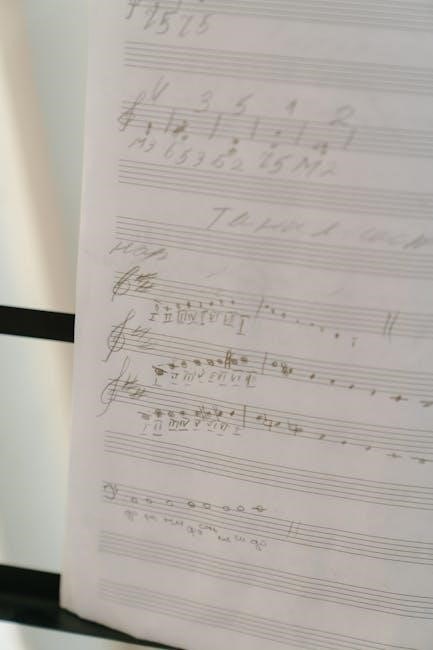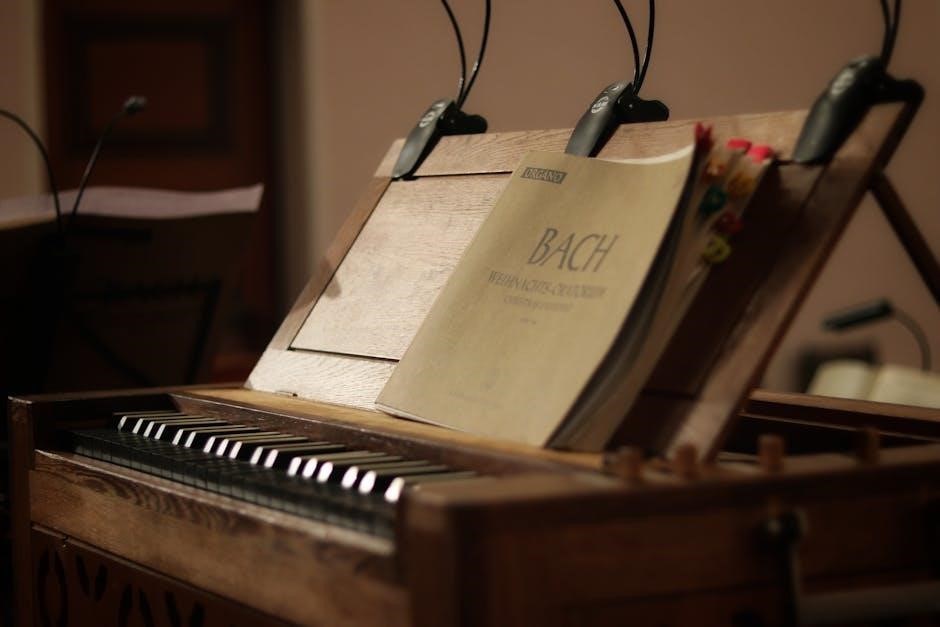
ab guide to music theory
Music theory is the universal language of music, providing essential tools to understand, analyze, and create compositions. It explores scales, chords, harmony, and rhythm, offering insights into musical structure and expression.
1.1 What is Music Theory?
Music theory is the study of the language and practices used in creating music. It encompasses notes, scales, chords, rhythm, and notation, providing the tools to compose, perform, and analyze music effectively. Understanding these elements allows musicians to express their ideas clearly and appreciate musical structures across various genres and styles. Music theory is a fundamental discipline that underpins all musical activities, offering insights into the workings of sound and composition.
1.2 Why is Music Theory Important?
Music theory is essential for understanding the structure and language of music. It enhances creativity, improves performance skills, and fosters deeper appreciation for musical compositions. By learning theory, musicians can communicate ideas effectively, interpret scores accurately, and compose with confidence. It also bridges gaps between different musical styles and genres, enabling collaboration and innovation. Whether composing, performing, or analyzing, music theory provides the foundation for mastering music and unlocking its full potential across all artistic and technical levels.
1.3 Brief History of Music Theory
Music theory has roots in ancient civilizations, with early systems developed by Greeks like Pythagoras. The Middle Ages introduced staff notation and modes. The Renaissance brought polyphony and counterpoint, while the Baroque era refined harmony. Classical periods established structured forms, and Romanticism emphasized emotion. The 20th century introduced modernism and jazz, expanding theory’s scope. Today, music theory remains a cornerstone, bridging past innovations with contemporary practices across diverse genres, from classical to pop and electronic music.
The Musical Alphabet and Basic Notation
The musical alphabet consists of seven natural pitches (A-G) and sharps/flats. Staff notation organizes these pitches on a five-line staff, with lines and spaces representing specific notes.
2.1 Understanding the Musical Alphabet
The musical alphabet begins with A and ends with G, repeating cyclically. Each letter represents a natural pitch, while sharps (#) and flats (♭) denote half-step variations. This system allows for precise communication of pitches, enabling musicians to read sheet music accurately. Understanding the sequence and relationships between these notes is foundational for analyzing scales, keys, and harmonies. The musical alphabet is a cornerstone of music theory, providing the vocabulary needed to express musical ideas clearly and effectively.
2.2 Staff Notation: Lines and Spaces
Staff notation consists of five horizontal lines and four spaces, where notes are placed to indicate pitch and rhythm. Each line and space represents a specific letter in the musical alphabet, with lines named E, G, B, D, F (Every Good Boy Does Fine) and spaces A, C, E (All Cows Eat Grass). Middle C is positioned on the first ledger line below the staff. This system allows precise placement of notes, enabling clear communication of musical pitches and durations. It has evolved from ancient notation systems into the standardized tool used universally today.
2.3 Note Values and Rests
Note values indicate the duration of a sound or silence in music. Common values include whole, half, quarter, eighth, and sixteenth notes, each halving the previous duration. Rests, which denote silence, correspond to these values. Dots can extend note or rest lengths by half their value. Understanding note values is crucial for interpreting rhythm and timing in sheet music, as they precisely communicate how long or short a pitch should sound or a silence should last within a composition.
Pitch and Clefs
Pitch refers to the highness or lowness of a sound, while clefs indicate the pitch range. Common clefs include treble, bass, alto, and tenor, each guiding how notes are read on the staff.
3.1 Understanding Pitch
Pitch is the perceived highness or lowness of a sound, determined by its frequency. It is a fundamental element of music, allowing us to distinguish between different notes. Pitch is represented on the staff using clefs and note positions, providing a visual guide for musicians. Understanding pitch is crucial for reading sheet music, playing instruments, and composing. It forms the basis of scales, intervals, and melodies, enabling the creation of harmonious and meaningful musical expressions.
3.2 Types of Clefs (Treble, Bass, Alto, Tenor)
Clefs are symbols that indicate the pitch of written notes on a staff. The most common clefs are Treble, Bass, Alto, and Tenor. The Treble clef is used for higher-pitched instruments, while the Bass clef is for lower-pitched ones. Alto and Tenor clefs are less common but essential for specific instruments like the viola and trombone. Each clef assigns a specific pitch to a line or space on the staff, ensuring musicians play the correct notes. Understanding clefs is vital for accurate music interpretation and performance.
Scales and Key Signatures
Scales and key signatures form the foundation of music, defining pitch organization and emotional depth. They guide composition and performance, shaping melodies and harmonies across genres.
4.1 Major and Minor Scales
Major and minor scales are fundamental pitch collections in music. The major scale creates a bright, uplifting sound, while the minor scale evokes a darker, more somber tone. Both consist of seven notes with specific whole and half-step intervals. Understanding these scales is crucial for composition, improvisation, and analyzing music across various genres. They form the basis for chord construction and harmonic progression, making them essential tools for musicians and composers alike.
4.2 Modes and Their Significance
Modes are variations of scales, each with a unique emotional character; Derived from the major scale, there are seven natural modes, each starting on a different note. They include Ionian, Dorian, Phrygian, Lydian, Mixolydian, Aeolian, and Locrian. Historically, modes were central to early music and remain influential in modern composition. Each mode evokes distinct moods, from the brightness of Ionian to the melancholy of Aeolian. Understanding modes enhances creativity in improvisation and composition, offering diverse harmonic possibilities across genres like jazz, classical, and rock music.
4.3 Key Signatures: Major and Minor Keys
Key signatures indicate the tonality of a piece, showing sharps or flats used in a specific key. Major keys convey optimism, while minor keys evoke sadness. Each key signature corresponds to a major or minor scale, defining the musical alphabet for the composition. Understanding key signatures is crucial for reading sheet music and grasping harmonic structure. They determine the pitch relationships and mood of a piece, guiding musicians in performance and composition across various musical genres.

Intervals and Chords
Intervals measure distances between pitches, forming the foundation of chords and harmony. Chords combine multiple pitches, creating complex sounds that define musical structure and emotional depth.
5.1 Understanding Intervals
Intervals are the building blocks of harmony, measuring the distance between two pitches in semitones. They can be ascending or descending, creating unique emotional moods. Harmonic intervals occur simultaneously, while melodic intervals are sequential. Intervals are classified as major, minor, perfect, diminished, or augmented, each with distinct qualities. Understanding intervals is crucial for composing, improvising, and analyzing music. They form the foundation of chords and scales, enabling musicians to create rich, layered sounds. Grasping intervals enhances your ability to craft meaningful musical progressions and harmonies.
5.2 Building Chords: Major, Minor, Diminished, Augmented
Chords are groups of three or more pitches sounding together, created by stacking intervals. A major chord consists of a root, major third, and perfect fifth, producing a bright, stable sound. Minor chords use a root, minor third, and perfect fifth, evoking a somber mood. Diminished chords, with a root, minor third, and diminished fifth, create tension, while augmented chords, featuring a root, major third, and augmented fifth, add dramatic color. These chords form the basis of harmony and are essential for composition and performance.
5.3 Inversions of Chords
Chord inversions rearrange the notes of a chord, creating new harmonic possibilities. A chord in root position has its root as the lowest note, while first and second inversions place the third and fifth in the bass, respectively. Inversions maintain the chord’s identity but alter its sound and function. They are used to add variety, smooth voice leading, and enhance harmonic progression in compositions. Understanding inversions is crucial for composing, arranging, and improvising, as they expand the versatility of chords in musical contexts.

Harmony and Progressions
Harmony and progressions are fundamental to music, involving the combination of pitches and chord movements. They create mood, structure, and emotional depth in compositions.
6.1 Basic Harmony Concepts
Basic harmony concepts form the foundation of understanding how chords and melodies work together. It introduces principles like chord progressions, voice leading, and harmonic function. These elements help create coherent and emotionally resonant music, guiding listeners through a musical narrative. Harmony concepts are essential for composing, arranging, and improvising, providing a framework for musical expression and structure. By mastering these basics, musicians can craft meaningful and engaging harmonic landscapes in their compositions.
6.2 Common Chord Progressions
Common chord progressions are recurring harmonic patterns used in music to create structure and emotional depth. Examples include the I-IV-V-I progression, often found in popular songs, and the I-vi-IV-V progression, known for its versatility. These progressions are fundamental in various genres, providing a framework for harmonic movement and resolution. Understanding common chord progressions enhances composition, improvisation, and analysis, allowing musicians to create meaningful and engaging musical experiences while maintaining harmonic coherence and emotional impact.
6.3 Cadences and Their Functions
Cadences are harmonic or melodic points that create a sense of closure or pause in music. They establish tonality, signaling the end of a phrase or section. Common types include the Perfect Cadence (V-I), which provides strong resolution, and the Imperfect Cadence (IV-I or I-V), offering less finality. The Plagal Cadence (IV-I) is often heard in hymns, while the Deceptive Cadence (V-vi) surprises listeners by avoiding expected resolution. Cadences shape emotional impact and structural clarity, guiding listeners through musical narratives and enhancing compositional depth.

Rhythm and Meter
Rhythm is the pattern of sounds in music, while meter organizes rhythms into groups, creating a structural framework. Syncopation adds complexity by emphasizing off-beat patterns, enhancing musical interest and expression.
7.1 Understanding Rhythm
Rhythm is the heartbeat of music, formed by patterns of duration and accentuation. It involves note values, rests, and syncopation, creating a sense of forward motion. Basic rhythms include whole, half, quarter, and eighth notes, with rests indicating silence. Dots and ties modify durations, while time signatures define meter. Rhythm can be simple or complex, depending on the interaction of these elements, providing structure and emotional depth to musical compositions.
7.2 Time Signatures and Meter
Time signatures and meter are fundamental to rhythm, indicating how music is measured and felt. A time signature consists of two numbers: the top denotes beats per measure, the bottom the note value. Common signatures like 4/4 (common time) or 3/4 (waltz time) establish meter. Meter is the rhythmic pattern created by strong and weak beats, guiding how notes are grouped and felt. Understanding time signatures and meter is crucial for playing and composing music with clarity and precision.
7.3 Syncopation and Accentuation
Syncopation and accentuation are rhythmic techniques that add complexity and emotion to music. Syncopation involves emphasizing off-beat or unexpected parts of a rhythm, creating a lively, dynamic feel. Accentuation refers to stressing specific notes to add emphasis or shape the musical contour. Both techniques enhance rhythm and meter, allowing for expressive interpretations. Understanding syncopation and accentuation is vital for performers and composers, as they add depth and energy to musical compositions, making them more engaging and emotionally impactful.

Musical Form and Structure
Musical form and structure organize compositions into coherent frameworks, creating balance and unity. Common forms include binary, ternary, sonata, and rondo, each shaping the musical narrative and emotional journey.
8.1 Binary and Ternary Forms
Binary form consists of two contrasting sections (AB), often used in dances like minuets. Ternary form features three sections (ABA), with the first and third being identical. Binary forms offer simplicity and contrast, while ternary forms provide balance and resolution. Both structures are fundamental in organizing musical ideas, allowing composers to explore themes and variations. Understanding these forms enhances the ability to analyze and create coherent musical compositions, making them essential concepts in music theory and composition.
8.2 Sonata Form and Rondo Form
Sonata form is a large-scale structure commonly used in symphonies and sonatas. It typically features an exposition, development, and recapitulation, with themes explored and resolved. The exposition introduces themes, the development elaborates them, and the recapitulation unifies the material. A coda often concludes the piece, providing closure.
Rondo form is characterized by a recurring theme (A) alternating with contrasting episodes (B, C, etc.); It creates a sense of variety and unity, often used in lighter or virtuosic works. Both forms provide composers with frameworks to explore musical ideas, balancing structure and creativity.
8.3 Understanding Musical Phrases
Musical phrases are similar to sentences in language, providing structure and meaning. They typically range from four to eight measures, with a clear beginning, middle, and end. A phrase often concludes with a cadence, creating a sense of completion or anticipation for what follows.
Understanding phrases is crucial for composition and interpretation. They help organize musical ideas, convey emotion, and guide the listener through the composition. Recognizing phrasing enhances performance and appreciation, as it reveals the composer’s intent and the music’s narrative flow.

Ear Training and Improvisation
Ear training enhances your ability to recognize musical elements like intervals, chords, and scales by ear, crucial for composition and improvisation. Improvisation involves spontaneous musical creation, relying on music theory knowledge to guide expressive and coherent performances.
9.1 Developing Your Musical Ear
Developing your musical ear involves training your ability to recognize and reproduce musical elements like intervals, chords, and scales. Start by listening to melodies and attempting to sing or play them back. Use solfège syllables (do, re, mi, fa, so, la, ti) to identify pitches. Practice identifying chord progressions and harmonic structures in songs. Regular ear training exercises, such as interval recognition drills, can significantly improve your skills. Over time, this enhances your ability to compose, improvise, and understand music intuitively.
9.2 Basics of Improvisation
Improvisation is the art of creating music spontaneously, relying on your musical ear and theoretical knowledge. Start by practicing over simple chord progressions, such as the major scale or common cadences. Begin with short phrases, focusing on melodic simplicity and emotional expression. Use scales, arpeggios, and motifs to build coherence. Listen to and imitate improvisations by masters to gain inspiration. Remember, improvisation is about freedom within structure—knowing music theory provides the foundation for creative exploration and meaningful expression.

Advanced Concepts
Advanced music theory explores complex techniques like counterpoint, fugue, and extended chord progressions, offering deeper insights into composition and harmonic analysis for sophisticated musical expression.
10.1 Counterpoint and Fugue
Counterpoint involves the interweaving of independent melodies, creating rich harmonic textures. A fugue is a complex contrapuntal composition where a theme (subject) is repeated and developed across voices. Fugal exposition introduces the subject and answer, often in contrasting keys, while episodes and invertible counterpoint add depth. Composers like Bach mastered these forms, showcasing their emotional and intellectual power. Understanding counterpoint and fugue enhances compositional skills and appreciation for intricate musical structures, bridging tradition and innovation in music theory.
10.2 Advanced Chord Progressions
Advanced chord progressions go beyond basic harmony, incorporating extended chords like 7th, 9th, and 11th chords. These progressions often use modulation and chromaticism to create complex, emotionally rich music. Techniques like reharmonization and altered dominants add depth, while modal interchange expands harmonic possibilities. Advanced progressions are widely used in jazz and contemporary music, offering composers and improvisers tools to craft sophisticated, nuanced soundscapes. Mastery of these concepts enhances musical expression and innovation, bridging tradition with modern creativity in harmony and composition.

Musical Analysis and Criticism
Musical analysis and criticism are essential for understanding compositions. They involve examining themes, harmony, and structure to evaluate and interpret musical works, enhancing appreciation and creativity.
11.1 Analyzing Musical Compositions
Analyzing musical compositions involves breaking down works into elements like themes, motifs, and chord progressions. This process reveals a piece’s structure, emotional depth, and historical context. By examining harmony, rhythm, and form, listeners gain insight into the composer’s intent and creative decisions. Practical analysis enhances performance, composition, and appreciation skills, while fostering a deeper connection to the music. It also aids in understanding cultural and stylistic influences, making it a vital tool for musicians and enthusiasts alike.
11.2 Understanding Musical Styles and Genres
Understanding musical styles and genres involves exploring the unique characteristics of different musical categories, such as classical, jazz, rock, and pop. Each genre is defined by its melodic, harmonic, and rhythmic elements, as well as cultural and historical contexts. By studying these styles, musicians and listeners can appreciate the diversity of music and its emotional impact. This knowledge also aids in composition, performance, and connecting with audiences, fostering a deeper appreciation for the richness of musical traditions and innovations across time and cultures.
The Psychology of Music Theory
Music theory shapes emotional experiences through harmonic progressions, melodies, and rhythms, influencing mood and psychological responses, creating a deep connection between sound and human emotion.
12.1 The Emotional Impact of Music
Music theory plays a crucial role in evoking emotions through its structural elements. Chords, scales, and harmonic progressions create moods, from joy to melancholy, guiding emotional expression. Composers use techniques like modulation and tempo to heighten feelings, while rhythm and melody deepen psychological connections. Understanding these principles helps musicians craft pieces that resonate universally, bridging cultural and linguistic barriers. The interplay of sound and emotion, shaped by music theory, creates profound, lasting impacts on listeners.
12.2 How Music Theory Influences Mood
Music theory shapes mood through chord progressions, scales, and rhythm. Major keys evoke happiness, while minor keys convey sadness. Tempo and dynamics further amplify emotional depth, with faster tempos increasing energy and softer dynamics creating introspection. Harmonic structures, like cadences, resolve tension, offering closure. These elements, guided by music theory, craft emotional landscapes, allowing composers to evoke specific moods and connect deeply with listeners. Understanding these techniques enhances the ability to manipulate and convey emotions effectively in musical compositions.
Resources for Learning Music Theory
Explore recommended books, online courses, and free printables. Essential guides like “The Complete Idiot’s Guide to Music Theory” and interactive tools simplify learning for all skill levels.
13.1 Recommended Books and Guides
Essential resources like “The Complete Idiot’s Guide to Music Theory” and “AB Guide to Music Theory” by Eric Taylor offer comprehensive insights. These books cover basics like reading music, scales, and harmony, with practical exercises. For beginners, “Harmonica Music Theory Guide” simplifies complex concepts. Additionally, online guides and free printables provide interactive learning tools. These resources cater to all skill levels, ensuring a solid foundation for understanding music theory. They are invaluable for musicians, composers, and educators seeking structured learning materials.
13.2 Online Courses and Tutorials
Explore online platforms like Coursera, Udemy, and MusicTheory.net for structured music theory courses. These resources offer interactive lessons, quizzes, and exercises tailored for all skill levels. Websites such as Teoría.com provide comprehensive tutorials and downloadable materials. Many courses include video lectures, ear training tools, and progress tracking. These online tools make learning music theory flexible and accessible, allowing you to study at your own pace and deepen your understanding of musical concepts.
Mastering music theory unlocks creativity and understanding, transforming your musical journey. This guide provides a solid foundation, encouraging lifelong learning and artistic expression through music.
14.1 Summarizing Key Concepts
Music theory provides the foundation for understanding music’s structure, from the musical alphabet to advanced concepts like harmony and counterpoint. Key elements include scales, chords, intervals, and rhythm, which form the building blocks of compositions. This guide emphasizes practical applications, such as reading sheet music and improvisation, while connecting theoretical knowledge to real-world musical experiences. By mastering these concepts, musicians can enhance their creativity, performance, and appreciation of diverse musical genres. This comprehensive approach ensures a well-rounded understanding for both beginners and advanced learners.
14.2 Encouragement for Further Study
Embark on a lifelong journey of musical discovery by continuing to explore music theory. With countless resources available, including books, online courses, and interactive tools, further study is both accessible and rewarding. Deepen your understanding of harmony, composition, and performance to unlock new creative possibilities. Whether composing, improvising, or simply appreciating music, consistent practice and study will enhance your skills and enrich your musical experiences; Keep exploring, and let music theory guide you to new heights of artistic expression and enjoyment.